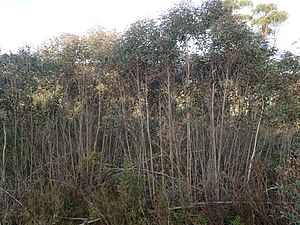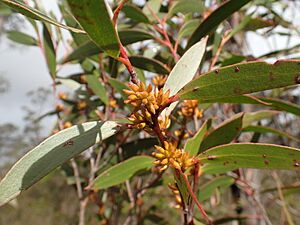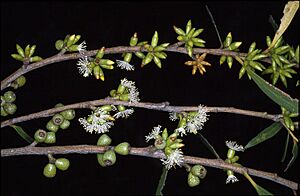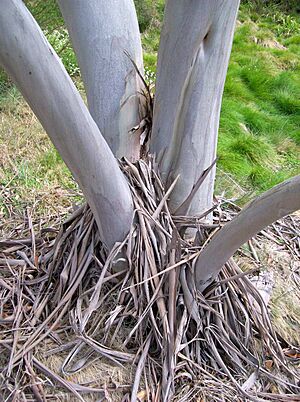Narrow-leaved sally facts for kids
Quick facts for kids Narrow-leaved sally |
|
|---|---|
 |
|
| Eucalyptus moorei in the Gibraltar Range National Park | |
| Scientific classification | |
| Genus: |
Eucalyptus
|
| Species: |
moorei
|
The Eucalyptus moorei, commonly called the narrow-leaved sally, is a special type of tree or large bush. It's known as a "mallee" because it often grows with many stems from its base. This plant is only found in New South Wales, Australia. It has smooth bark, long, narrow leaves, and its flowers are white. After flowering, it produces small, cup-shaped fruits.
What Does the Narrow-leaved Sally Look Like?
The narrow-leaved sally is a mallee that usually grows to be about 6 to 10 meters tall. It has a special woody swelling at its base called a lignotuber. This helps the plant regrow after events like bushfires.
Young plants have leaves that sit directly on the stem. This means they are "sessile." These leaves are arranged in opposite pairs. They are usually 28 to 45 millimeters long and 6 to 25 millimeters wide.
Adult leaves are arranged one after another along the stem. They are narrow and shiny green on both sides. These leaves are typically 30 to 90 millimeters long and 4 to 13 millimeters wide. They grow on a small stalk called a petiole, which can be up to 8 millimeters long.
The plant's flower buds grow in groups of 7 to 15. They appear where the leaves meet the stem, which is called the "axil." These bud clusters are on a short stalk called a peduncle, which is 1 to 7 millimeters long. Each individual bud might sit directly on the stalk or have a tiny stalk of its own, called a pedicel, up to 1 millimeter long.
Mature buds are shaped like a top. They are 5 to 7 millimeters long and about 2 millimeters wide. Each bud has a cone-shaped or horn-shaped cap called an operculum. The narrow-leaved sally flowers between February and May, and its flowers are white.
After flowering, the plant produces a woody fruit. This fruit is a cup-shaped or rounded "capsule." It is 4 to 5 millimeters long and 3 to 6 millimeters wide. The parts that open to release seeds, called "valves," are tucked inside the rim of the fruit.
How Did it Get Its Name?
The Eucalyptus moorei was first officially described in 1905. Two scientists, Joseph Maiden and Richard Hind Cambage, wrote about it. They found a sample of the plant in the highest parts of the Blue Mountains. Their description was published in a scientific paper.
Later, in 1999, two other scientists, Ian Brooker and David Kleinig, described two different types of E. moorei. These types are called "subspecies." They are different because of the size and shape of their young leaves. These subspecies are:
- Eucalyptus moorei subsp. moorei: This type has young leaves that are oval-shaped and 6 to 25 millimeters wide.
- Eucalyptus moorei subsp. serpentinicola: This type has young leaves that are very narrow, only 2 to 7 millimeters wide.
The scientific name moorei honors a botanist named Charles Moore. The name serpentinicola is interesting because it refers to where this subspecies grows. It only grows in hills with red soil that is found over a type of rock called "serpentinite."
Where Does the Narrow-leaved Sally Grow?
The narrow-leaved sally grows in sandy soil. It is often found in areas with low, shrubby plants called "heath." Sometimes, it grows in places where the soil doesn't drain very well. It can also be found on exposed sandstone areas.
You can find this plant in several places in New South Wales. These include the Gibraltar Range, the Blue Mountains, the Tinderry Range, and in the Wadbilliga National Park. The subspecies serpentinicola is only known from an area near Gloucester.




